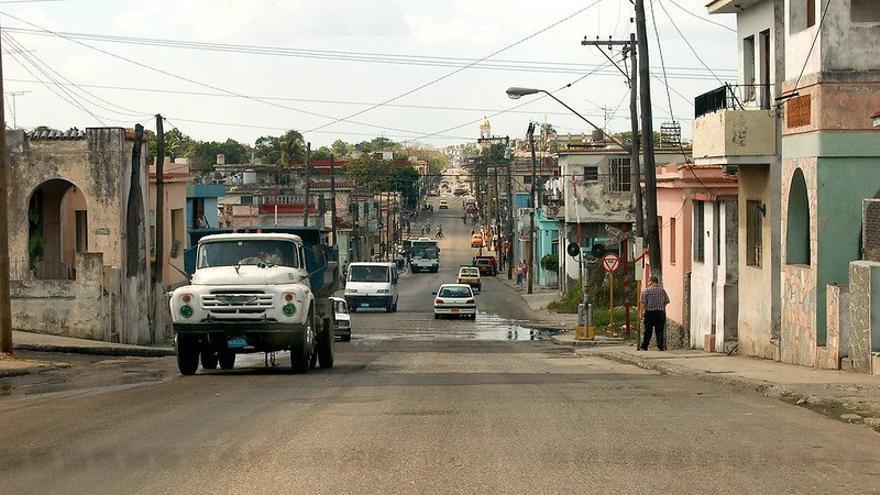
14ymedio, Havana, July 9, 2020 — The epidemiological situation is complicated in Havana, and the light at the end of the tunnel never arrives. This couldn’t be better said. On Wednesday, while part of the capital was living in a blackout that lasted for nine hours, the authorities, in their daily meeting about supervising the pandemic, were claiming that the “consumption of electricity” is stable.
It was only one of many good-news articles that they wanted to send through the official press. There’s chicken, “there’s no problem with the supply of flour,” the bank branches in the whole country are working and Guantánamo and Santiago de Cuba are keeping a lid on Covid-19.
Transport is also in a favorable situation, and even the sale of tickets is beginning on Thursday in the province of Matanzas, which has entered into phase two, for travel beginning on Tuesday, according to Eduardo Rodríguez Dávila, the Minister of Transport.
Everything is going well, according to the Government. Less so in Havana, of course, where there hasn’t been electricity, transport doesn’t function (the First Minister said he received complaints of overcrowding, and the President requested staggering work hours to avoid crowds), and the pandemic hasn’t abated.
On Tuesday, they activated isolation measures for four blocks of Pilar-Atarés, in the municipality of Cerro, yesterday they announced the closure of a quadrant of Lawton, in Diez de Octubre, and the strengthening of monitoring measures in Arroyo Naranjo. Without forgetting that a focus point in Centro Habana is still active.
Some 7,000 people were affected by the isolation in Lawton, where they detected four cases of coronavirus in the last few days, covering the perimeter between Fonts, Aguilera and Calle 13 to the west; Calle D in the south, Porvenir to the west, and Calle 14 y Juanelo to the east. The area is divided, in turn, into two zones: one for the population that lives in one of them, which includes 10 blocks, where PCR (polymerase chain reaction) tests were given; while for the remaining group, 16 blocks long, they will do rapid testing.
Among the measures that the residents have to live with, in addition to tests and monitoring, is the use inside and outside their homes of masks, which is difficult to supervise; although, according to the official press, severe actions will be taken if citizens violate the provisions.
In addition, hawking remains prohibited, as does the increased sale of chlorine, hypochlorite and disinfectants, and the homeless population will be attended to. The authorities also have said that they will distribute food and water to homes of the vulnerable population and will organize commercial activity to minimize the usual tumult associated with buying.
The authorities will control the perimeter from 8:00 pm, as well as the seven bus stops on routes 1 and 23, so that no one will get off.
Until the results of the tests are released, no one can leave the zone, insisted Luis Antonio Torres Iríbar, President of the Consejo de Defensa Popular (Popular Defense Council). He urged that food be guaranteed for the residents and asked for “conscience and discipline.”
The situation in Arroyo Naranjo is different. There have barely been two cases of Covid-19 in 15 days, with known sources of contagion and contacts, who tested negative. However, its proximity to the province of Mayabeque, where there have been cases, has been the motivation for taking measures.
In this sense, the norms are more general: maintaining distance, using a mask, washing hands, disinfecting homes and other areas with a solution of water and alcohol.
Also, more medical attention has been requested, and supervision for taking temperatures and testing the population, beginning with work centers. Supplies of food and articles of hygiene are equally needed.
“You have to remember that these places are on the front line of Covid, not in the first phase of recuperation, and, thus, they must comply with all the measures,” said Torres Iríbar in reference to the affected zones in the capital, like Centro Havana, San Miguel del Padrón, Cotorro and Cerro. In Cerro, the most recent, confirmed cases now reach 20, although El Cotorro continues to be the municipality with the highest rate of incidence.
Yanet Hernández Pérez, the Vice Governor of Havana, claims that the province fulfills the five criteria noted for being in the first phase of recuperation: the rate of incidence, the reproductive index, the number of active cases, the positives whose source of infection is known in the last 15 days and number of events open to the public.
Translated by Regina Anavy
_________________
COLLABORATE WITH OUR WORK: The 14ymedio team is committed to practicing serious journalism that reflects Cuba’s reality in all its depth. Thank you for joining us on this long journey. We invite you to continue supporting us by becoming a member of 14ymedio now. Together we can continue transforming journalism in Cuba.
